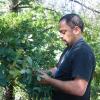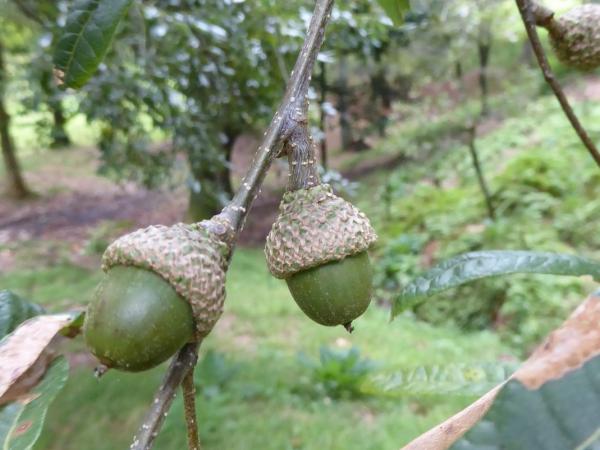Editor's Picks
Plant Focus
Hybrid or Not?
A very valid question arose from my recent blog post, On the Hunt for Hybrids. While it is very well known that oaks hybridize, can you call every oak you may find with atypical leaves, bark, or acorns a hybrid? A retired horticulture professor friend of mine is fond of saying “...if you can’t tell for sure what it is, just call it a hybrid”. He may not be that far off, but the question remains, how can you be sure if you have an actual hybrid, or variation within a species?
Every species was originally described by a botanist (usually eons ago) from a single plant or a group of plants. These descriptions include leaf shape, color, number of lobes (if any), pubescence (or lack of), petiole length
 |
 |
| Varietal differences within the same species (Quercus alba) | |
and color, peduncle length and size, etc., etc. Given the wide geographic range that many species cover, one can assume that the original description could not possibly cover every variation within a species.
It stands to reason that a Quercus alba growing in the far north of its range would potentially appear different than one growing in its southern limits, yet in fact represent one species. Following this logic, there are is an acceptable “range” of characteristics for each species and these ranges vary depending on soil structure, pH, nutrients, competition, etc. A great example of this is Q. macrocarpa. In northern regions, bur oaks typically have very wide, shallowly lobed leaves with small caps and acorns. In the southern regions you can find bur oaks with deeply sinused leaves with large caps and acorns, yet they are considered the same species. This is simply a matter of growing conditions and daylight hours. Larger leaf mass can photosynthesize more efficiently and small acorns take a shorter amount of time to mature in the shorter growing season of the north. In southern
 |
| Photo: Guy Sternberg |
regions, due to longer growing seasons, bur oaks can afford to spend more time growing the large size fruits that most associate with the species and from which it draws its species epithet (macro-large, carpa-fruit). This represents the range of a single species, not a series of hybrids.
So, when is a hybrid a hybrid? Well, I look for markers outside of what is considered normal for a species. For example, I recently found a young Q. ×leana (Q. imbricaria × velutina) on my property. The leaves were elongated like Q. imbricaria, but lobed like Q. velutina. However, these lobes were shallow and terminated at a single point unlike pure Q. velutina. The acorns are smaller than typical Q. velutina, but larger than typical Q. imbricaria with light reddish-brown, domed caps featuring lightly appressed scales. When taken together, these features did not fit within the tolerances of either species, but show introgression from two separate species. The fact that these two species made up the whole of this particular fence line, just made identification easier.
These are observations that all of us can make, and there isn’t a fool proof way to determine parentage; unless of course you have genetic testing capabilities which most of us do not. Suppose you have found a first generation (F1) hybrid. The “tried and true” way to determine parentage of said hybrid is to grow seedlings and observe their characteristics. There will typically be a range of traits that favor one parent (grandparent actually) or the other, and those that look very much like the (F1) hybrid itself. By observing the two outlier groups, many times, you can determine, rather precisely, original parentage.
 |
Here it comes; but you must also be aware of the possibility that this second (F2) generation may not be self-pollinated, but could be crossed back to one parent or a third species (F3) entirely. Is that clear as mud?
I should mention that I am not a professional botanist or taxonomist, but find this kind of work very interesting. Hopefully this helps explain the process and energizes people to run towards hybrid oaks instead of away from them.











